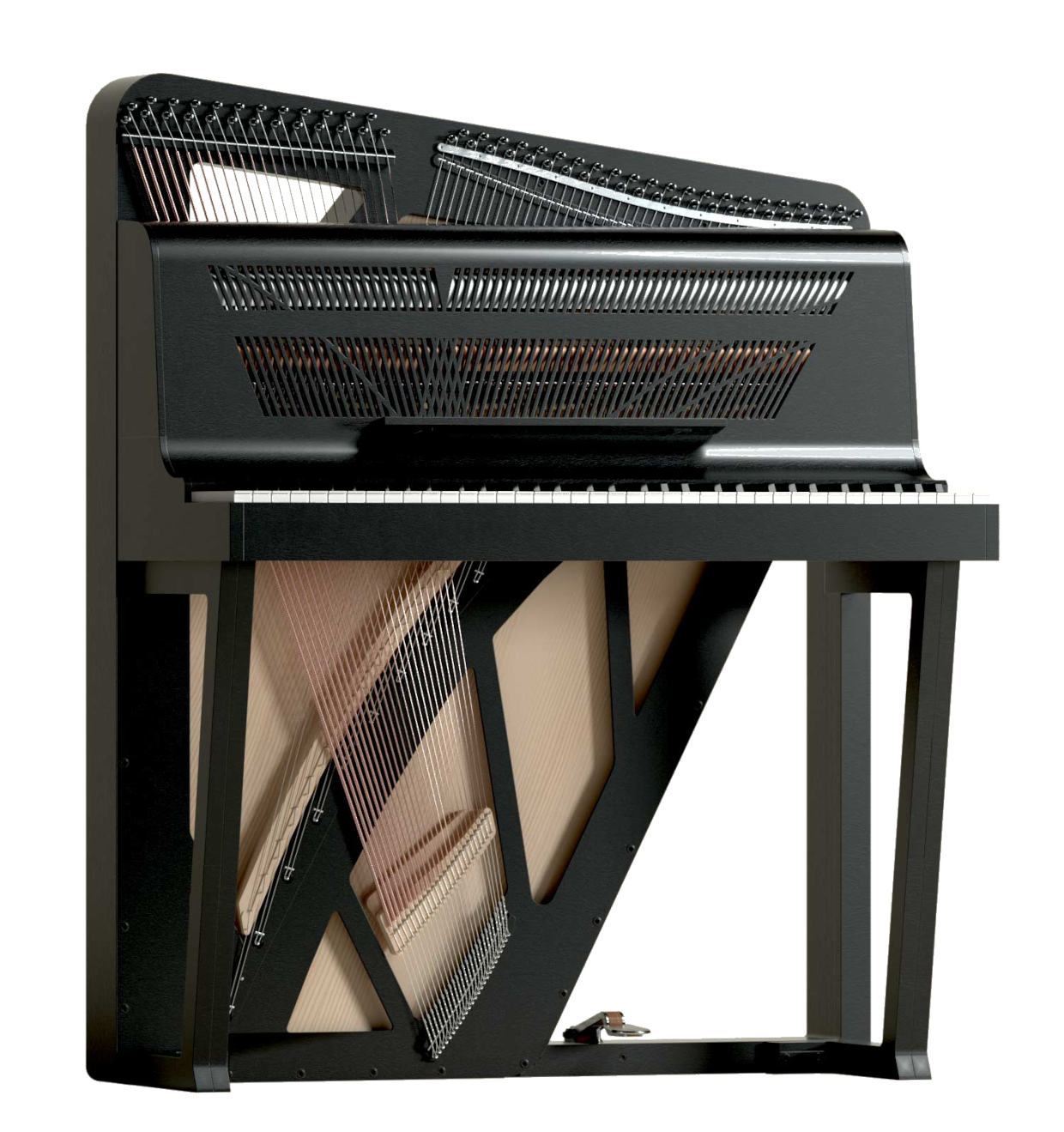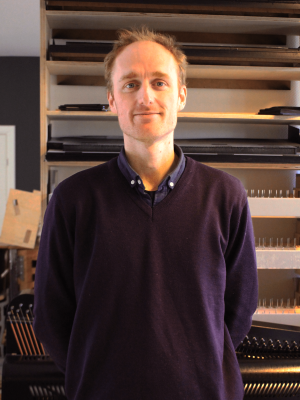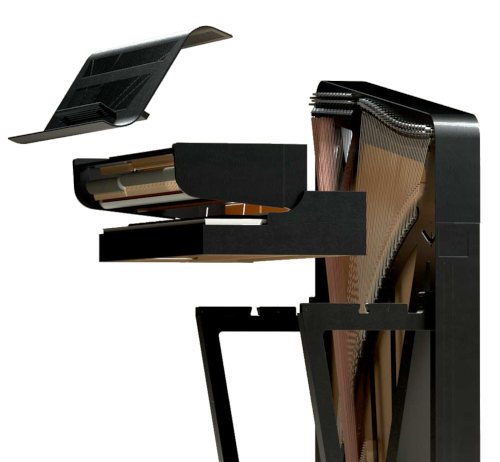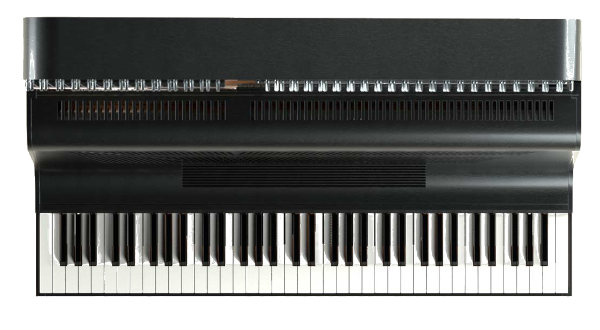Many years ago, I remember seeing a piano in a museum similar to the one shown above (built in 1787 by Christian Gottlob Hubert. On display at Germanisches Nationalmuseum – Nuremberg, Germany). I have often wondered why acoustic portable pianos never really took off. Although we’ve seen more portable keyboard instruments like harpsichords, accordions or electronic keyboards, they operate completely different from a traditional piano in that they either pluck the strings, use air with reeds, or play back a recording to create sound. This is unlike a real piano that utilizes mallets to strike the strings. But when you play these early pianos from the late 1700’s, they don’t really resemble pianos like we know them today. These portable pianos had a thin, tinny sound due to light-weight strings, much like guitar strings. In the evolution of the piano, there was a desire for better tone, and bigger sound, having lush warmth with beautiful sustain. In order to achieve these qualities, however, more strings and thicker strings were added. This created a problem – adding more strings meant more tension and more tension required more structural integrity and so, cast iron was implemented to create the rigidity to withstand more than
19 tons of string tension of a modern piano. As we all know, iron creates weight, and the weight makes for an instrument that isn’t portable. Really petite modern pianos today weigh 375 lbs (170 kg) while concert grands can weigh as much as 1550 lbs! (700kgs!). But still my thoughts of a portable piano have remained, wondering what a modern take on an old concept might look like.
Well this year at the NAMM show, the Keybird piano was the fulfillment of that concept. It is unlike anything I had ever seen and truly is the embodiment of the modern ideal of a portable piano. Weighing in at 130 lbs (59 kg), it disassembles even further into components to become even more portable and even fits into the trunk of a car!

 I had the wonderful opportunity to talk to Lander Pinson from Denmark, whose brainchild this is to bring it to fruition.
I had the wonderful opportunity to talk to Lander Pinson from Denmark, whose brainchild this is to bring it to fruition.
Glen Barkman: Lander, this piano is incredible! How did you begin working on this project?
Lander Pinson: This actually grew more out of necessity as I was in university and staying in a home where there was no piano. I grew up in a home where there was always a piano. My accommodations physically were impossible to get a piano inside. And so I thought, I wonder if a piano would still function if I cut the middle section out of it and removed the cast iron frame. This was my first experiment. Since I was also in school for mechanical engineering, this idea appealed to me. Shortly after, I started working on a design for a lightweight piano.

GB: Taking apart the piano and removing the cast iron, what changes?
LP: The biggest difference is that you really can’t have 3 strings per note because it creates too much tension. Reducing this to 1 string per note changes the sound for sure but the goal has always been to make the best portable piano possible and that requires some compromises.
GB: I like it! My impression is that the X1 sounds like a hybrid between an acoustic piano and mid-60’s Rhodes stage piano. It has less sustain than a piano but still a great sound – especially for those interested in stage work. It has a mellow tone as well. The touch feels great. I feel that this is a real accomplishment. How did you go from your first experiment to this piano in full production?
LP: This is the result of about 7 years and 10 prototypes. You learn a lot when you start making a piano. With my mechanical engineering background, I was thinking that it would be interesting to create every aspect of the piano. Over time, you realize that with some parts, it’s simply better and easier to buy existing ones. Like the action parts, for example – the levers that propel the hammer forward and make it ready to repeat – those parts are complex. And so I had to learn that some things were worth investing time into while other aspects, it’s more effective to go with pre-built components.
 GB
GB: What are the key features of the Keybird X1?
LP: Well first and foremost, the piano is portable. To make something truly portable, you need to fit it into a car. The Keybird is 40″ wide, making it fit into most vehicles. The weight is 59 Kg (130 lbs) and while that still is substantial, it’s about one quarter of the weight of a traditional piano. The keyboard comes off of the frame, making transportation easier. The keys are actual, full-sized keys. We made a 69 key keyboard which ranges from low E to the top C key. Recognizing that some might want to use this as a quiet or silent piano, we also have MIDI optical sensors under the keys as an add-on option.
GB: The rest of the piano works just like a regular piano?
LP: Yes, correct. The keys are wooden. The traditional action parts used for repetition are wooden and the hammers are made from wool like any other piano. It has a wooden backpost frame and a spruce soundboard to amplify the tone. We have incorporated a damper pedal, which is the one you use 98% of the time.
GB: And do you hire a piano tuner to tune this?
LP: You don’t need to. Pianos have usually about 225 tuning pins. The Keybird X1 has only 69. Having only one string per note, it doesn’t have the same issues with tuning unisons that regular pianos have. We recommend an app so that you can tune it yourself in about 20-30 minutes whenever you like! We have also posted some tutorials on how do that.
GB: What have the challenges been bringing an idea like this into production? I imagine that’s an uphill learning curve. Musicians are not engineers and engineers are not manufacturers and manufacturers are not marketers…
LP: Exactly. All has been a learning curve. After many prototypes, then there’s lots of back and forth with manufacturing this to scale. There’s always changes that need to be made and adjusted. Regarding marketing and distribution, we’re just getting the word out there. We’ve created an online portal to purchase directly at Keybird. We’re still in the early stages of streamlining shipping but it’s really exciting to see this project come to life.
GB: Congrats on doing this. I think it’s a fantastic idea and I hope that those looking for a portable piano or a piano to fit into tight spaces will consider getting one of your instruments. Speaking of which, how do I buy one?
LP: Simply go to the Keybird store and you will find everything you need to get one.
Many thanks to Lander Pinson for the interview and check out the Keybird site for more details.